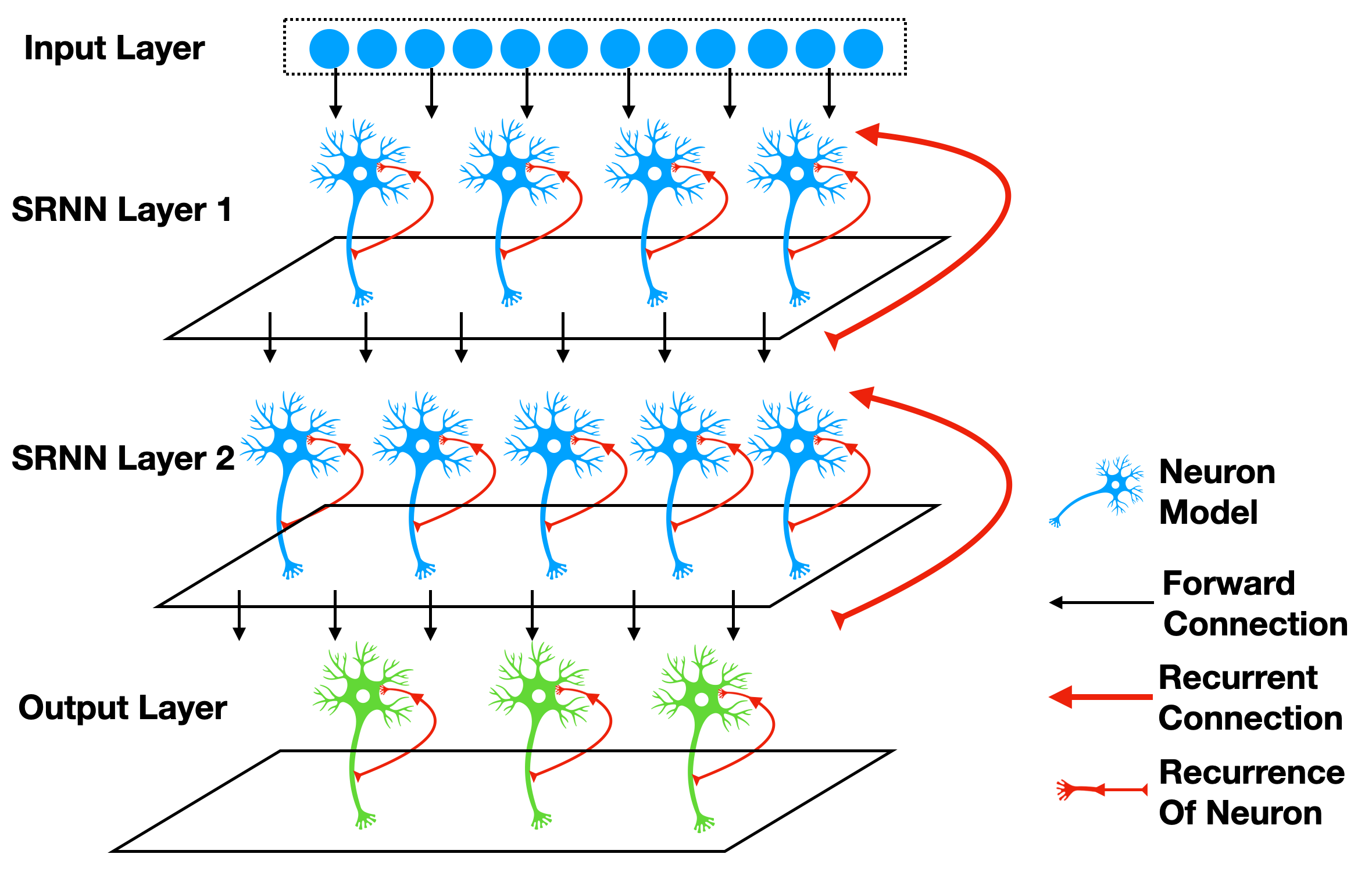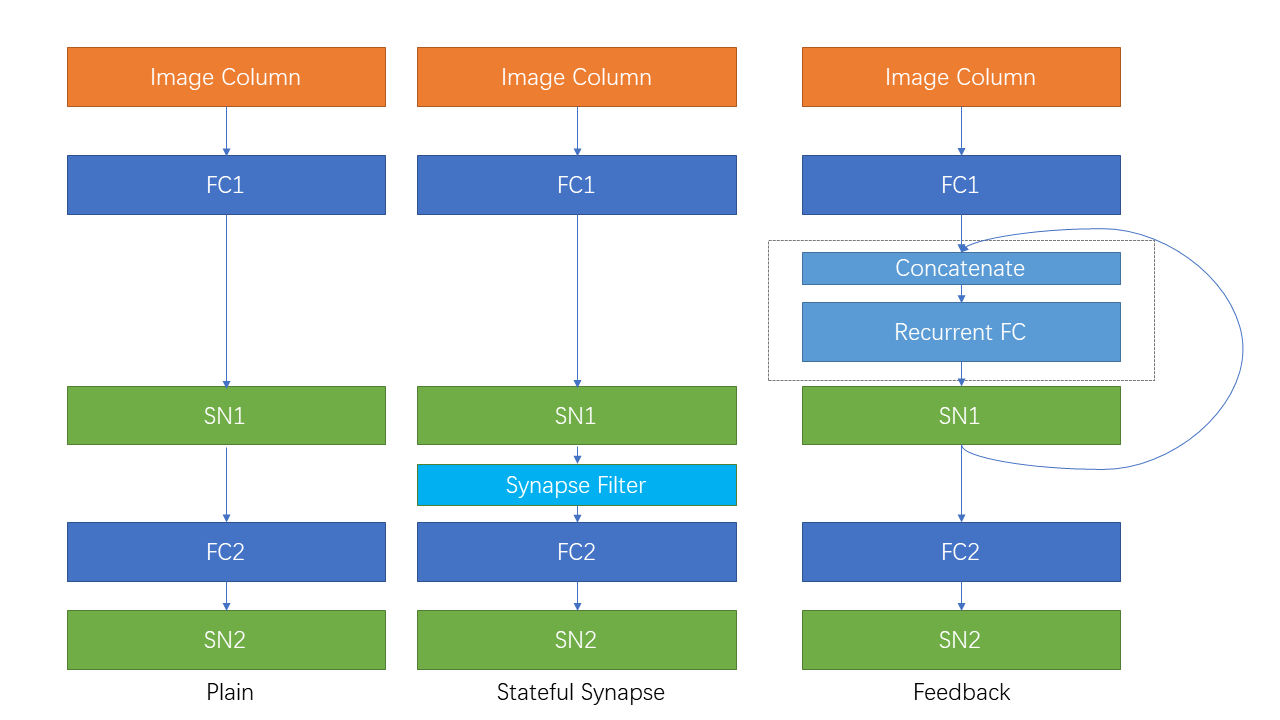Recurrent Connections and Stateful Synapses
Author: fangwei123456
Recurrent Connections
The recurrent connections connect a module’s outputs to its inputs. For example, 1 uses a SRNN(recurrent networks of spiking neurons), which is shown in the following figure:

It is easy to use SpikingJelly to implement the recurrent module. Considering a simple case that we add a connection to make
the neuron’s outputs \(s[t]\) at time-step \(t\) can add with external inputs \(x[t+1]\) at time-step \(t+1\).
It can be implemented by spikingjelly.clock_driven.layer.ElementWiseRecurrentContainer. ElementWiseRecurrentContainer
is a container that add a recurrent connection to the contained sub_module. The connection is a user-defined element-wise
function \(z=f(x, y)\). Denote the inputs and outputs of sub_module as \(i[t]\) and \(y[t]\) (Note that
\(y[t]\) is also the outputs of this module), and the inputs of this module as \(x[t]\), then
where \(f\) is the user-defined element-wise function. We set \(y[-1] = 0\).
Let us use ElementWiseRecurrentContainer to contain a IF neuron, and set the element-wise function as add:
We use soft reset, and give the inputs as \(x[t]=[1.5, 0, ..., 0]\):
T = 8
def element_wise_add(x, y):
return x + y
net = ElementWiseRecurrentContainer(neuron.IFNode(v_reset=None), element_wise_add)
print(net)
x = torch.zeros([T])
x[0] = 1.5
for t in range(T):
print(t, f'x[t]={x[t]}, s[t]={net(x[t])}')
functional.reset_net(net)
The outputs are:
ElementWiseRecurrentContainer(
element-wise function=<function element_wise_add at 0x000001FE0F7968B0>
(sub_module): IFNode(
v_threshold=1.0, v_reset=None, detach_reset=False
(surrogate_function): Sigmoid(alpha=1.0, spiking=True)
)
)
0 x[t]=1.5, s[t]=1.0
1 x[t]=0.0, s[t]=1.0
2 x[t]=0.0, s[t]=1.0
3 x[t]=0.0, s[t]=1.0
4 x[t]=0.0, s[t]=1.0
5 x[t]=0.0, s[t]=1.0
6 x[t]=0.0, s[t]=1.0
7 x[t]=0.0, s[t]=1.0
We can find that due to the recurrent connection, even if \(x[t]=0\) when \(t \ge 1\), the neuron can still fire because its output spike is fed back as input.
We can use spikingjelly.clock_driven.layer.LinearRecurrentContainer to implement a more complex recurrent connections.
Stateful Synapses
There are many papers using stateful synapses, e.g., 2 3. We can put spikingjelly.clock_driven.layer.SynapseFilter after a stateless synapse to get the stateful synapse:
stateful_conv = nn.Sequential(
nn.Conv2d(3, 16, kernel_size=3, padding=1, stride=1),
SynapseFilter(tau=100, learnable=True)
)
Ablation Study On Sequential FashionMNIST
Now we do a smple exmperiment on Sequential FashionMNIST to check whether recurrent connections and stateful synapses can promote the network’s temporal information fitting ability. Sequential FashionMNIST is using FashionMNIST as input row-by-row
or column-by-column, rather than the whole image. Consequentially, the network classify Sequential FashionMNIST correctly
only when it can learn long-term dependencies. We will feed the image column-by-column, which is same with reading texts from left to right. Here is the example:

The following gif shows the column being read:

First, let us import packages:
import torch
import torch.nn as nn
import torch.nn.functional as F
import torchvision.datasets
from spikingjelly.clock_driven.model import train_classify
from spikingjelly.clock_driven import neuron, surrogate, layer
from spikingjelly.clock_driven.functional import seq_to_ann_forward
from torchvision import transforms
import os, argparse
try:
import cupy
backend = 'cupy'
except ImportError:
backend = 'torch'
Now let us define a plain feedforward network Net:
class Net(nn.Module):
def __init__(self):
super().__init__()
self.fc1 = nn.Linear(28, 32)
self.sn1 = neuron.MultiStepIFNode(surrogate_function=surrogate.ATan(), detach_reset=True, backend=backend)
self.fc2 = nn.Linear(32, 10)
self.sn2 = neuron.MultiStepIFNode(surrogate_function=surrogate.ATan(), detach_reset=True, backend=backend)
def forward(self, x: torch.Tensor):
# x.shape = [N, C, H, W]
x.squeeze_(1) # [N, H, W]
x = x.permute(2, 0, 1) # [W, N, H]
x = seq_to_ann_forward(x, self.fc1)
x = self.sn1(x)
x = seq_to_ann_forward(x, self.fc2)
x = self.sn2(x)
return x.mean(0)
We add spikingjelly.clock_driven.layer.SynapseFilter after the first spiking neurons layer and get StatefulSynapseNet:
class StatefulSynapseNet(nn.Module):
def __init__(self):
super().__init__()
self.fc1 = nn.Linear(28, 32)
self.sn1 = neuron.MultiStepIFNode(surrogate_function=surrogate.ATan(), detach_reset=True, backend=backend)
self.sy1 = layer.MultiStepContainer(layer.SynapseFilter(tau=2., learnable=True))
self.fc2 = nn.Linear(32, 10)
self.sn2 = neuron.MultiStepIFNode(surrogate_function=surrogate.ATan(), detach_reset=True, backend=backend)
def forward(self, x: torch.Tensor):
# x.shape = [N, C, H, W]
x.squeeze_(1) # [N, H, W]
x = x.permute(2, 0, 1) # [W, N, H]
x = self.fc1(x)
x = self.sn1(x)
x = self.sy1(x)
x = self.fc2(x)
x = self.sn2(x)
return x.mean(0)
We add a recurrent connection spikingjelly.clock_driven.layer.LinearRecurrentContainer from the first spiking
neurons layer’s output to itself and get FeedBackNet:
class FeedBackNet(nn.Module):
def __init__(self):
super().__init__()
self.fc1 = nn.Linear(28, 32)
self.sn1 = layer.MultiStepContainer(
layer.LinearRecurrentContainer(
neuron.IFNode(surrogate_function=surrogate.ATan(), detach_reset=True),
32, 32
)
)
self.fc2 = nn.Linear(32, 10)
self.sn2 = neuron.MultiStepIFNode(surrogate_function=surrogate.ATan(), detach_reset=True, backend=backend)
def forward(self, x: torch.Tensor):
# x.shape = [N, C, H, W]
x.squeeze_(1) # [N, H, W]
x = x.permute(2, 0, 1) # [W, N, H]
x = seq_to_ann_forward(x, self.fc1)
x = self.sn1(x)
x = seq_to_ann_forward(x, self.fc2)
x = self.sn2(x)
return x.mean(0)
The following figure shows the three networks:

The complete codes are available at spikingjelly.clock_driven.examples.rsnn_sequential_fmnist. We can run it in console, and the running arguments are
(pytorch-env) PS C:/Users/fw> python -m spikingjelly.clock_driven.examples.rsnn_sequential_fmnist --h
usage: rsnn_sequential_fmnist.py [-h] [--data-path DATA_PATH] [--device DEVICE] [-b BATCH_SIZE] [--epochs N] [-j N]
[--lr LR] [--opt OPT] [--lrs LRS] [--step-size STEP_SIZE] [--step-gamma STEP_GAMMA]
[--cosa-tmax COSA_TMAX] [--momentum M] [--wd W] [--output-dir OUTPUT_DIR]
[--resume RESUME] [--start-epoch N] [--cache-dataset] [--amp] [--tb] [--model MODEL]
PyTorch Classification Training
optional arguments:
-h, --help show this help message and exit
--data-path DATA_PATH
dataset
--device DEVICE device
-b BATCH_SIZE, --batch-size BATCH_SIZE
--epochs N number of total epochs to run
-j N, --workers N number of data loading workers (default: 16)
--lr LR initial learning rate
--opt OPT optimizer (sgd or adam)
--lrs LRS lr schedule (cosa(CosineAnnealingLR), step(StepLR)) or None
--step-size STEP_SIZE
step_size for StepLR
--step-gamma STEP_GAMMA
gamma for StepLR
--cosa-tmax COSA_TMAX
T_max for CosineAnnealingLR. If none, it will be set to epochs
--momentum M Momentum for SGD
--wd W, --weight-decay W
weight decay (default: 0)
--output-dir OUTPUT_DIR
path where to save
--resume RESUME resume from checkpoint
--start-epoch N start epoch
--cache-dataset Cache the datasets for quicker initialization. It also serializes the transforms
--amp Use AMP training
--tb Use TensorBoard to record logs
--model MODEL "plain", "feedback", or "stateful-synapse"
Let us train the three networks:
python -m spikingjelly.clock_driven.examples.rsnn_sequential_fmnist --data-path /raid/wfang/datasets/FashionMNIST --tb --device cuda:0 --amp --model plain
python -m spikingjelly.clock_driven.examples.rsnn_sequential_fmnist --data-path /raid/wfang/datasets/FashionMNIST --tb --device cuda:1 --amp --model feedback
python -m spikingjelly.clock_driven.examples.rsnn_sequential_fmnist --data-path /raid/wfang/datasets/FashionMNIST --tb --device cuda:2 --amp --model stateful-synapse
The train loss is:
The train accuracy is:
The test accuracy is:
We can find that both feedback and stateful-synapse have higher accuracy than plain, indicating that recurrent
connections and stateful synapses can promote the network’s ability to learn long-term dependencies.
- 1
Yin B, Corradi F, Bohté S M. Effective and efficient computation with multiple-timescale spiking recurrent neural networks[C]//International Conference on Neuromorphic Systems 2020. 2020: 1-8.
- 2
Diehl P U, Cook M. Unsupervised learning of digit recognition using spike-timing-dependent plasticity[J]. Frontiers in computational neuroscience, 2015, 9: 99.
- 3
Fang H, Shrestha A, Zhao Z, et al. Exploiting Neuron and Synapse Filter Dynamics in Spatial Temporal Learning of Deep Spiking Neural Network[J].